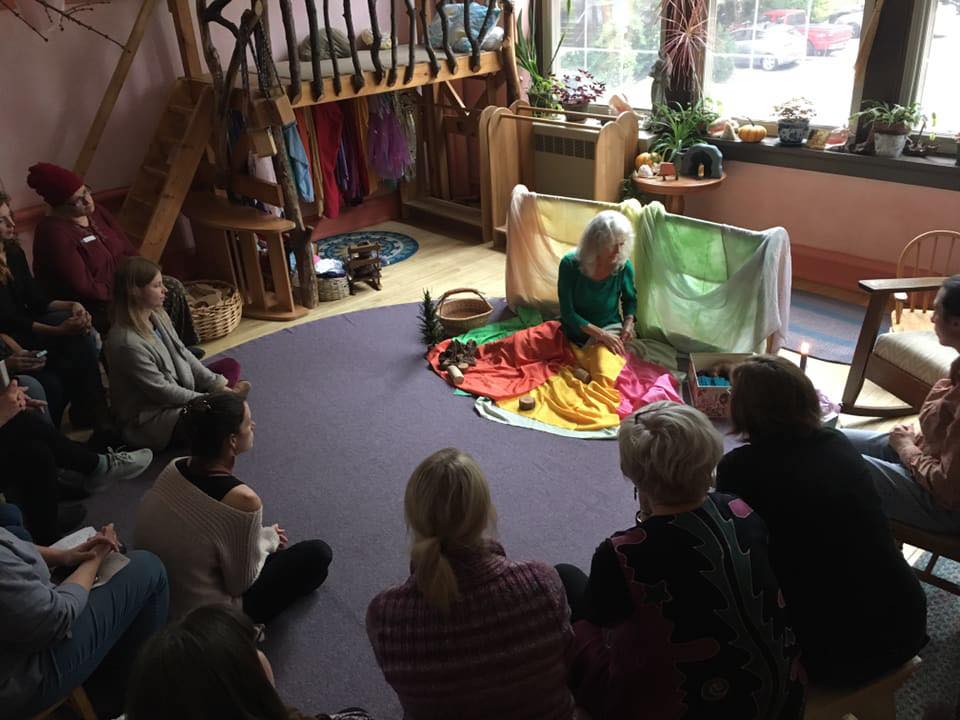December 15, 2019
In the midst of winter, I found there was, within me, an invincible summer. – Albert Camus
The darkest nights of the year approach, and people all across the northern hemisphere enter into a time of waiting for the light to return. Jews, Christians, and pagan and earth-centered faiths all mark in their own way the annual return of the sun. This week’s story from Sharifa Oppenheimer features the robins, who kindle the fire for the child in the manger, bringing light and warmth to the cold darkness.
These stories contain age-old truths no matter what spiritual path you follow. If they speak to your heart, we invite you to share them with the children as we continue towards the Winter Solstice, awaiting the return of the sun on the other side.
Blessings on your waiting,

Mary O’Connell, Your Living Arts Weekly blog editor
Creative Exploration
Stories for the Early Winter
from Sharifa Oppenheimer

Just before Christmas, I like to tell these winter stories. They are stories of transformation, which image for the young child the forces of growth, in the natural world as well as within the kingdom of humanity. I tell each story for one week, with the Christmas story as the last one.
There are many winter stories from various traditions and cultures, especially within our temperate climate, which use the images of light being born out of darkness. I have chosen to focus on this particular tradition because it is familiar culturally. For me the telling of these stories is a way to wrest the deep spiritual significance of the cyclic transformation of light (and its corollary importance in the human soul) from the societal marketers and money magicians. These stories image the transformation of consciousness, beginning with the story of the mineral kingdom in the crystalline formation of the snowflakes, moving through the plant kingdom with the story of a little fig tree, and on to the animal kingdom in a story of the birds and the animals’ speech. The final one is the transformation of our humanity, the story of the “child of light,” the Christmas story itself. In each story, we see the central figure take a step in evolution; we see something brand-new appear. I have been told these stories come from an ancient medieval tradition. They are stories to delight and inspire!

Robin’s First Christmas (Third of a series)
As you remember, once, a very long time ago, an old man and a young woman took a long icy winter’s journey. Because there was no room at the inn, they slept at night in a humble stable, with the animals’ sweet breath warming them, and golden hay for a bed. A baby was born to them that night. Although the old man made a small fire to warm the baby, still the infant was cold. At the baby’s cry, the old man put on his cloak. He went out into the snowy night to gather more wood, that the fire might burn warmer, to comfort the baby’s tears.
So, the young woman was left alone. She needed to rock her baby and keep him wrapped snug, but also to tend the tiny fire of straw and sticks, keeping it alive till the old man returned. This was not easy for the young woman. She was quite cold herself. Every time she stood up to gather a few more sticks, the baby’s wrappings loosened, and he cried more pitiably. Each time she sat holding and rocking her baby, the little flames burned low, threatening to go out altogether. Back and forth she went, working between the fire and her very cold little baby. She tried not to cry, herself, knowing it would upset him even more to hear her tears. Yet her eyes glistened in the firelight.
Now, this stable was made in such a fashion that up above, in the roof rafters, there were snug places, out of the wind and weather. Here a flock of little brown birds nestled through the winter. The birds had been watching, with their bright and curious eyes, all the surprising events of the evening. They saw the young woman’s plight, and chatted, in their chirping voices, together.
“That poor baby is so cold.”
“Do you know, humans don’t even get to have feathers when they are babies!”
“Why, in the great blue sky, not? It would help everything so much, don’t you agree?”
Many little feathered heads bobbed up and down.
“Well, feathers would certainly help keep him warm, but he hasn’t got any. So, maybe we can help in another way.”
There was a flurry of wings, and tiny birdcalls. Suddenly the young woman saw a wee brown wing swoop low over the fire. She saw one piece of straw drop from an orange beak onto the smoldering fire beside her. The flames licked up the hay, hungry for more. Straw by straw, the flock of birds gathered and fed the flames. The fire burned more steadily, now, and the baby grew calmer.
One bird, in particular, loved the baby’s dear smile, and wanted to stay close beside him. So, this special little brown bird made it his duty to stand near the fire. He flapped his feathered wings to fan the fire until the old man might return. He was happy to just be near this tiny new human being.
At last, the door opened with a whoosh of snow and cold. The old man threw down a great bundle of pine boughs, and got to work quickly. When at last the fire was cheery and the baby slept soundly, the young woman saw that one small bird was still standing on the stable floor, close beside her and her son. She looked carefully at him, and then she saw something that touched her heart. He had stood close to the fire, fanning the flames for so long, that his little round tummy had been burned! Now, his tummy was red! She reached out her hand and touched him, and then all the hurt went away.
“Because you love my baby so much and stood so close to the fire, from now on you and all your children, and all your ever-ever-so-great grandchildren will have red breasts. And you will be the bird best-loved by children all over the world.” So, the very first robin red-breast twittered happily and merrily flew to his family in the rafters above.
And everyone was happy indeed.
[Sharifa Oppenheimer is the author of Heaven on Earth: A Handbook for Parents of Young Children and What is a Waldorf Kindergarten. She taught young children for 35 years and now loves teaching adults through the LifeWays trainings. She also travels offering lectures which explore the ways in which the latest findings in brain research support Steiner principles. Sharifa lives with her husband in an enchanted forest in Virginia, and is the mother of three grown sons, who were raised within the Waldorf tradition.]Nurturing Care

Won’t you join us to begin the year 2020 by bringing more intention and joy to your home life? You can still join us for the Winter edition of Living Arts Through the Seasons! Our themes for the winter are:
December – Inner Light
January – Being Thrifty
February – Balance
Click here to learn more!
